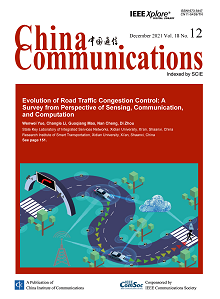COMMUNICATIONS THEORIES & SYSTEMS
Wenjun Xu, Wei Chen, Yongjian Fan, Zhi Zhang, Xinxin Shi
2021, 18(12): 230-251.
We consider a spectrum efficiency (SE) maximization problem for cooperative power beacon-enabled wireless powered communication networks (CPB-WPCNs), where each transmitter harvests energy from multi-antenna power beacons (PBs) and transmits data to the corresponding receiver. %Specifically, we consider the out-band wireless energy transfer scenario, where energy signals and information signals are transmitted over different frequency bands, meaning that the wireless energy transfer and the data transmission are performed simultaneously. For data transmission, both orthogonal transmission, i.e., the time splitting (TS) mode, and non-orthogonal transmission, i.e., the interference channel (IC) mode, are considered. Aiming to improve the system SE, the energy beamformers of PBs, the transmit power, and the transmit time duration of transmitters are jointly optimized. For the TS mode, the original non-convex problem is transformed into a convex optimization problem by means of variable substitution and semidefinite relaxation (SDR). The rank-one nature of this SDR is proved, and then a Lagrange-dual based fast algorithm is proposed to obtain the optimal solution with much lower complexity. For the IC mode, to conquer the strong non-convexity of the problem, a branch-reduce-and-bound (BRB) monotonic optimization algorithm is designed as a benchmark. Furthermore, a low-complexity distributed successive convex approximation (SCA) algorithm is presented. %, which enables parallel and efficient on-line implementation of the proposed scheme. Finally, simulation results validate the performance of the proposed algorithms, achieving optimality within only 1%$\sim$2% computation time compared to the CVX solver in the TS mode and achieving 98% of the optimal performance in the IC mode.
